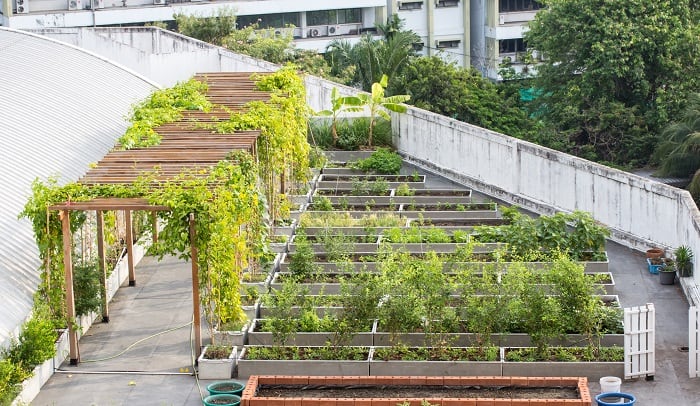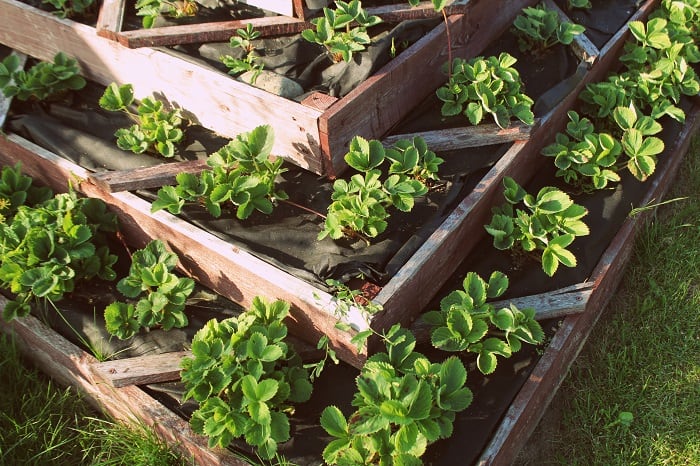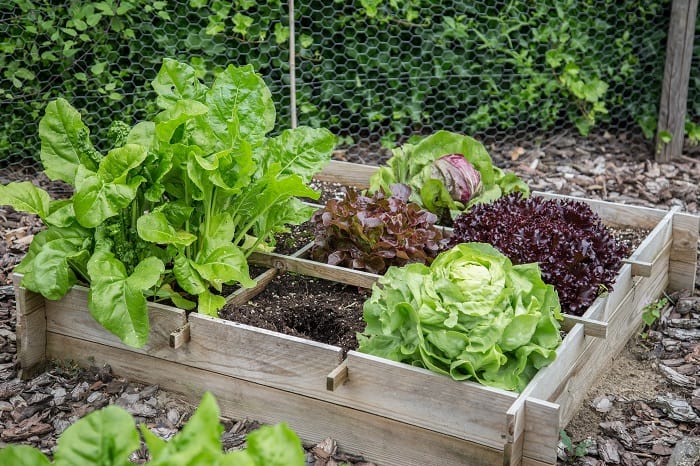Last Updated on October 29, 2022
If you’re struggling with keeping your garden organized, then you might surely appreciate raised garden beds. After all, raised bed gardens allow you to maintain your plants with ease while keeping your garden orderly at the same time.
In its simplest form, you can think of a raised bed as a flower box with no bottom. You don’t have to step inside the raised bed; instead, you do all the gardening work from its outer perimeter. With all the advantages it has, let us talk about what you should consider before you start building yours:
Raised Garden Bed Considerations
Size
On average, raised beds normally span between 3-4 feet wide and 6-8 feet long. With this, you can reach into the bed with ease from the side to start planting your crops and removing weed without the need to step inside the garden. As a result, you’ll be avoiding the risk of compacting the soil.
Height is another important consideration. If you plan to place your raised bed on a flat, hard surface, then you’d have to make sure it is deep enough for your plants to root (this is especially true for root vegetables such as carrots and beets).
However, if it ended up too shallow, then the roots will reach down to the subsoil then hit a wall. Ideally, you’d want to go for at least 10 to 12 inches.
Read more about Spacing For Vegetables In Raised Beds
Soil Type
The amount of soil you need for your raised bed will actually depend on a few factors. To help you determine, you can instead use some soil calculators out there, such as this one from Gardener’s Supply.
When it comes to the size of the soil, I would highly recommend using high-quality soil which you can afford for your garden. You can use a triple mix which you can buy from a local supplier then combine it with organic vegetable compost. You’d also want to leave a few as a reserve for your bed throughout the season.
Location
Location is a really important factor you should consider when building a raised bed garden. It doesn’t necessarily have to be in your backyard. You can either place it on your front yard or the driveway.
However, if you have a slope, you’ll have to make some adjustments. You should also determine if the area drains well or not.
In order to make sure your plants can receive optimum health, you should place your raised garden bed in a location which can receive at least eight hours of sunlight exposure every day. Avoid placing it in a low, wet area where the soil can become soggy. Also, make sure the location has a hose nearby. Even before you place the raised garden bed in its permanent location, make sure you clean the area first by removing any grass or weed present.
Grass Removal
One of the most common concerns gardeners face is proper grass removal. If you’ve tried cutting or removing sod, then you know how hard of a task that can be. However, an easy way that can help you get rid of grass is to outline the space then have it covered with cardboard then soil afterward.
Using this method, the grass will simply break down, especially when done during the fall where everything will break down over the winter.
Irrigation
The last thing you want to consider when building a raised bed is irrigation. If you’re planning to set up a whole drip irrigation system, then you’d want to complete the process before finishing your raised bed.
This way, you can allow the hoses to run under pathways then adapt your raised bed around where the hose is attached to the irrigation system.
Why You’d Want to Consider Raised Bed Gardening
A lot of gardeners are starting to embrace the idea of raised bed gardening. In case you haven’t joined the trend yet, then here are some of the reasons that might convince you:
Easy Maintenance
With a raised bed, you can easily maintain your garden and tend your plants. This is because there’s no need to bend over as it’s basically elevated above the ground. This removes any strain on the back and knees which is common on traditional gardening.
Also, there’s the fact that you can get creative when building your bed, allowing you to customize it however you want. You can even raise it to standing level if you want. You can also place wheels to make it mobile. Of course, there will be people who’ll point out that it’s actually a planter.
However, it’s really just semantics. After all, raised beds don’t have bottoms.
Less Weeds
Another thing that makes raised bed gardening appealing is the fact that you can reduce the total number of weeds in your garden. There are several reasons for this; however, it mostly has to do with the design.
In case you’re somewhat confused, allow me to do a bit of explaining.
When preparing a garden bed, you’ll start by cleaning the ground where it’s going to be placed. This would involve removing any weeds found on the topsoil. Ideally, you’d want to remove the rocks as well.
Some gardeners choose to lay cardboard or newspapers under the garden bed in an effort to prevent weeds and grass from growing back. The best part is, since they are biodegradable, they will eventually decay and provide nutrients which the plants can use later on.
After that, the garden bed is then filled with nutrient-rich soil. Due to its nice and loose nature, any weed or grass that grows can be pulled with ease. It will also limit the growth rate of weeds, thus allowing you to reduce the number of weeds that can grow in your garden.
Improved Soil Drainage
Another reason why you’d want to consider raised bed gardening is because it can help improve soil drainage. This is because the soil which is used on a raised bed is never stepped, hence preventing the possibility of compacting it.
Also, a raised garden bed will allow the water found in the soil to freely drain, allowing enough air to get to the roots of the plants. Keep in mind that excess or standing water can only end up choking your crops.
When deciding on a soil to use for your garden bed, make sure you go for one which is rich in nutrients and organic matter. Don’t go for potting soil as it can drain too quickly. Also, pay attention to the amount of manure you combine into your soil mixture. This is because it is high in nitrogen, and too much nitrogen can end up stunting the growth of your plants.
Soil Erosion Prevention
This is one major advantage of raised bed gardening which you shouldn’t take lightly. The act of preventing soil erosion with the use of a raised garden bed can actually be a major selling point, especially if you’re living in an area which receives a lot of rain.
Most gardeners often have to deal with their soil being eroded due to rain, and this could mean a lot more work for them. There’s also the fact that buying high-quality soil can be quite expensive. Due to a raised garden bed’s design, you can prevent your precious soil from getting eroded during rains.
Aesthetically Pleasing
This could be one of the major reasons why a lot of gardeners are starting to get in on the raised bed gardening trend! After all, raised beds are so cool and aesthetically pleasing. There’s the fact that you can use your creativity as well as imagination to create a custom design for your garden bed.
There are also some gardeners who used raised garden beds as accents for their yards and gardens.
What You Want to Plant
Once you have set up your raised garden bed, you have the freedom to plant it with any type of vegetable you want. If you’re a fan of salad, you can choose to plant cherry tomatoes, lettuce, carrots, and cucumbers. Meanwhile, if you’re into cooking, you can plant peppers, potatoes, onions, and herbs.
Gardening in a raised garden bed will be all about maximizing productivity. The challenge you should face is growing as many crops as possible without planting too many. After all, if you end up overcrowing the bed, your plants won’t be able to reach their full potential due to poor air circulation, nutrients, and water.
You should also consider the growth habit of each plant you want to as it will affect the growth of the other plants in the same bed. For example, planting carrots alongside lettuce is okay. However, planting lettuce along with a cucumber could be a problem.
FAQ’s
What plants can raised gardens be used for?
Raised garden beds can be used for any type of plant, but they are most commonly used for vegetables. Raised garden beds can make gardening easier, as you don’t have to worry about your plants growing into your neighbors’ property.
If you’ve got a small space, raised beds can also be a great way to grow more food in a small area. You can even use them to grow flowers or herbs. Raised garden beds are easy to build, and it doesn’t take a lot of effort to create them.
What are the advantages?
They can be used anywhere. Raised garden beds can be used for any type of plant, but they are most commonly used for vegetables.
Raised garden beds are easier to use and maintain than traditional garden beds, because they don’t require much effort. You just have to put the soil in and then add your plants, and that’s it! There is no need to dig holes or worry about the soil getting too wet or dry.
They are more convenient Raised garden beds are more convenient than traditional garden beds because you don’t have to get your hands dirty when you’re planting your plants. You can plant and harvest in the same day, making it easy for you to grow your own food. You can also grow a variety of crops in the same bed without worrying about how they will grow together.
They are cheaper Raised garden beds are cheaper than traditional garden beds. This is because you only need to buy a few materials instead of buying a whole lot of soil. You can even save money by using recycled materials to build them. You can also reuse old pots, which can be useful if you have a lot of them lying around.
They are eco-friendly Raised garden beds are more eco-friendly than traditional garden beds, as they don’t use much water. If you use organic fertilizers, you won’t have to worry about the excess fertilizer ending up in the soil. You can even recycle used plastic pots and create a raised garden bed.
What are some steps to make one yourself?
Step 1 – Make the Raised Bed The first step to creating a raised garden bed is to cut the wood into pieces. The size of the bed will depend on your needs. If you have a small garden, you can make it as small as 8 feet by 8 feet.
If you are planning to build a larger bed, make it as large as you can. I recommend that you use 8-10 ft. of lumber for each side of the bed. For example, if your garden is 12 ft. wide and 16 ft. long, then you will need 16 ft. of lumber for each side of the bed. It’s best to use two boards for each side of the bed. You will also need to cut 2-3 ft. of lumber for the front and back. You will need to cut the boards at 45 degrees. This allows you to create an arch effect in the bed. To make the bed, you will need to attach the boards together with screws. For this project, I recommend that you use 10 ft. of wood screws. For the front and back, you will need to cut a piece of wood so that it fits into the gap between the boards. Use a piece of wood that is 3/4″ thick. This will allow you to fasten the front and back of the raised garden bed together.
Step 2 – Attach the Paving Stones The next step is to attach the paving stones to the bed. I prefer using concrete blocks for this purpose. They are inexpensive and easy to find. It’s best to use a cement block that is about 1/2 inch thick. It’s important that the cement blocks be flat on both sides. You can also use bricks or pavers instead of cement blocks. If you are using cement blocks, you will also need to cut some pieces of wood for the top of the bed. These should be about 1/2 inch thick. You will need to cut two boards for each side of the bed. This will allow you to attach the boards to the cement blocks. You will then need to attach the boards with screws. This is an easy project, but it takes some time.
Step 3 – Plant Your Garden In this step, you will plant your garden. You will need to consider several factors when planting a garden. The first factor is the size of the garden. You want to make sure that you have enough room to place the garden. The second factor is the type of plants that you plan to grow. Some plants are better suited for certain environments than others. For example, I prefer to plant tomatoes and peppers in my garden. But if you are planning to plant flowers or herbs, you may need to use different types of plants. It’s best to start out by choosing a small number of plants. If you want to plant a larger garden, you can add more plants as you progress.
Step 4 – Watering and Fertilizing You will want to water the plants at least once per week. If you live in an area with dry soil, you may want to add some compost to the bed. This will help to retain moisture. You will also need to fertilize the plants as needed.
Conclusion
With a raised garden bed, you can have an easier and more enjoyable means of gardening. You can benefit from its easy maintenance, aesthetic value, less weed issues, and possible erosion prevention.
Are you planning to consider a raised garden bed? Maybe you already have one in your garden. What are your thoughts about it? Will you be able to harvest your crops successfully? Let us know in the comments.
Also, don’t forget to share this information with your gardener friends. Thanks for reading!

Josephine is an enthusiastic gardener who loves to spend her spare time tending to her garden. She is passionate about growing her own food, and aspires to one day have her own vegetable garden. Josephine is also an animal lover and often takes in stray cats and dogs. She enjoys spending time with her pets in the garden, and is often seen playing with them or watering her plants. Josephine is an avid reader and enjoys learning about new gardening techniques and plants. She is always looking for ways to improve her garden and make it more beautiful. She is a great friend, always willing to lend a helping hand when needed. Josephine‘s passion for gardening and love of animals make her a wonderful addition to any garden.



